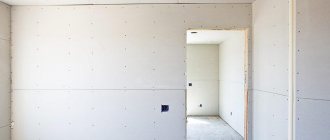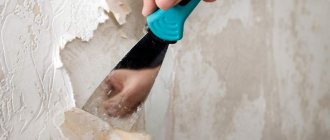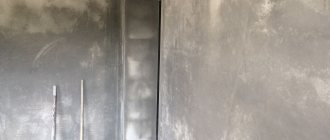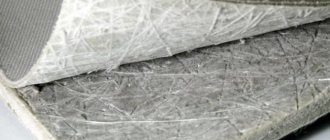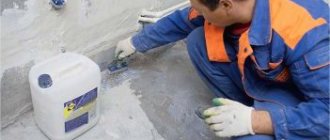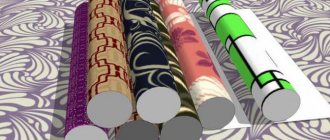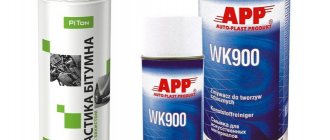Preparatory stage of work
The procedure can be carried out with your own hands, thus saving money and performing simple decorative manipulations yourself.
The work does not require specialized skills and is carried out quickly. Before painting a foam ceiling plinth, select the type of paint and the product itself. In addition, it is necessary to carry out preparatory work on the surface and eliminate all visible defects. We suggest considering the procedure for preparing foam plastic products for painting directly on the wall. To get started, prepare your tools:
- container with water;
- sponges;
- gloves;
- rubber spatula;
- cloth for wiping hands.
On video: how to decorate a ceiling plinth.
If you don't have a suitable spatula at home, you can use cardboard or a small plastic spatula. Initially, it is necessary to cover the ceilings with skirting boards. After this, a fine dispersion finishing putty is used. It is applied with a finger or a spatula and the joints are carefully covered. Before painting the ceiling plinth, it is important to also apply putty to all visible holes between the wall and the ceiling decoration fixtures.
Be careful not to accidentally cover up the relief pattern. To do this, fill all the cracks with a thin layer and remove the remaining material with a sponge. The peculiarity of polyurethane products is that they are quite fragile and can break under force. Don't forget about this when filling the seams.
Advice! After the putty has completely dried, go over the cornice with fine-grit sandpaper to ensure better adhesion of the surface to the paint.
Types of paints
Knowing that the material of the ceiling plinth for painting is loose and has certain properties, never use mixtures based on white spirit or solvent for painting. It is easy to ruin the product with such a coloring composition. For work, use paints based on water-dispersed mixtures.
The peculiarity of applying such paint to polyurethane baseboards is that solid polymer substances, concentrated in water, remain on the surface of the product, forming a dense layer of film of a certain color. Water evaporates when it dries. In addition, when choosing how to paint a foam plastic ceiling plinth, pay attention to the fire safety of the composition and its environmental friendliness.
Today the following types of paints are on sale:
- Acrylic. It has excellent decorative qualities that are not lost even after many years of use. Painting ceiling plinths with this mixture guarantees the consumer resistance to color fading, water resistance and vapor permeability. The product will “breathe”, which is very important for rooms with high humidity.
- Polyvinyl acetate paints for ceiling skirting boards. Ideal for rooms with dry temperatures and no constant exposure to moisture. This paint should only be used in corridors or other rooms not exposed to dampness. Polyvinyl acetate compounds are not water-repellent.
- Latex. These mixtures have proven themselves to be excellent in damp areas. The coloring of baguettes forms a hard film that does not absorb water. In addition, the products can be washed with detergents and a damp cloth. The only disadvantage of this paint is its ability to fade in the sun, so this mixture is perfect for the bathroom.
Choose paint based on the purpose of the room in which the ceiling plinth will be installed. Water-based mixtures are also good for coating polyurethane foam products; they have an affordable price and good protective properties.
Why is painting the baseboard necessary?
When purchasing ceiling fillets, consumers often do not think about painting them. Since the ceiling is made in white, why not leave the baseboards in the same color scheme? This decision is to some extent incorrect. Painting the baseboard is necessary, as it provides the product with the following properties:
- Often, polyurethane foam baseboards have minor defects and dents; this is not a big deal, but in bright lighting and when the light hits the product at a certain angle, all scratches become visible.
- Foam plastic is characterized by low density, sometimes products are translucent, and paint will give them a solid and modern look.
- When answering the question of whether it is necessary to paint the ceiling plinth, remember that white polyurethane foam is subject to fading in the sun and also collects dust particles.
- Painted parts are much easier to clean; to do this, you just need to wipe them with a damp cloth.
- The main problem when gluing white fixtures is the visibility of the joints, but paint allows you to hide these transitions.
- Painting the foam ceiling plinth will help create the right combination of wallpaper or paint finishes with the products.
In the video: is it necessary to paint a foam plastic ceiling plinth?
It is best to paint the product before gluing it to the wall. It is at this moment that the painting will be comprehensive, but on the wall you will have to additionally protect the finish from paint.
Do I need to paint foam ceiling skirting boards if they are already white? If you decide to leave the original color, painting is still necessary. You can also use white paint for this. This procedure will give the product additional strength and protection from external factors.
How to paint a floor plinth
When the finishing work reached its final phase, it was time for the final touch in the interior design - installing and painting the baseboard. We will look at how to paint a floor plinth in a suitable tone and choose a paint so that there is harmony in the interior.
A floor plinth is needed to close the gap between the wall and the floor around the perimeter of the room. In addition, today almost all skirting boards have a cable - a channel that allows you to place cables in it.
There is currently a huge range of materials for skirting boards, but we will consider only those types that need to be painted.
Types of skirting boards for painting
Wooden is an environmentally friendly building material, strong, resilient, easy to maintain, durable, and has a respectable appearance. They are installed mainly on parquet, wood and in dry rooms.
MDF - made from compressed wood fiber, mounted mainly on laminate, linoleum, and other floor coverings. Beautiful, does not fade from sunlight, environmentally friendly, resistant to pollution, easy to clean, easy to care for, but fragile from a strong impact, inferior to wood in terms of durability.
Manufacturers offer ready-to-install MDF products or unpainted planks, the color of which you can choose and paint yourself.
Before considering how to paint a floor plinth, let’s decide on the range of paints and varnishes for this work.
Paint for floor skirting boards
When applied, alkyd paints (enamels) form a durable and dense water-repellent film on the surface that is resistant to mechanical damage and detergents.
They should be applied to a dried baseboard, since otherwise, when the fillet dries, bubbles will appear on the paint layer, which will lead to peeling of the painted layer. The drying time is short, but a significant drawback is that these materials have an unpleasantly pungent odor.
Acrylic enamel is a water-based composition, so the surface of the treatment breathes. In addition, it is moisture-resistant, odorless, easy to care for, does not dry for long, and is characterized by durability and fire safety properties.
The list could go on for a long time - these include polyurethane varnishes and paints, oil paints are still in use today, all kinds of varnishes and other modern paints and varnishes. To highlight the texture of the wood, you can simply coat the product with alkyd varnish, if desired, pre-impregnated with stain.
Non-standard methods of painting ceiling fillets
Fans of original ideas for room decoration will definitely be interested in non-standard ways of painting ceiling plinths.
For example, fillets with large, relief patterns can be given the appearance of a stone surface. To do this you need:
- 1. Glaze of the appropriate shade is applied to the surface of the baseboard.
- 2. Using a brush, make small light strokes.
- 3. The surface is covered with dark spots (Umber glaze is used).
- 4. Small strokes of dark shades are applied.
- 5. All excess is removed from the surface of the baseboard.
- 6. After everything is dry, touches of a bronze shade are applied.
- 7. The fillets finally dry out and become like a stone surface.
A good designer will definitely figure out how best to combine these ceiling plinths with other design elements of the room so that it acquires a harmonious and original look.
Thus, painting foam ceiling plinths turns into a real art. You have the opportunity to get not only the “stone effect”, but also other interesting colors and shades:
- Malachite.
- Patina.
- Gold.
- Aged wood.
But do not forget that the listed options can only be used if they “fit” into the overall design of the room. “Golden” or “malachite” skirting boards are unlikely to be suitable for a room decorated in a modern style.
Important Precautions
Painting the baseboard yourself is a fairly simple task. However, it requires certain precautions to be taken. The order in which the work is performed will vary depending on whether the fillet is painted before or after installation.
Before starting processing, all products will need to be cleaned of dust and, if possible, primed.
If the baseboard is already installed, but the walls and ceiling are not yet finished, then you can use a spray can for painting.
If the baseboard has not yet been installed or is installed on an as yet unfinished wall, you can use spray paint. And if the walls and floors in the room are already finished, they will need to be protected from paint. Masking tape will help you with this. Apply it along the baseboards, making sure there are no exposed areas.
Related article: Green curtains in the living room interior - universal design
When peeling off the tape, decorative coating may be removed from the wallpaper, or the wallpaper itself may peel off from the surface. To prevent this from happening, you can use another protective measure. You will need cardboard or thin plastic and a wide spatula. To protect the surface, a spatula will need to be applied to the appropriate area during the painting process.

